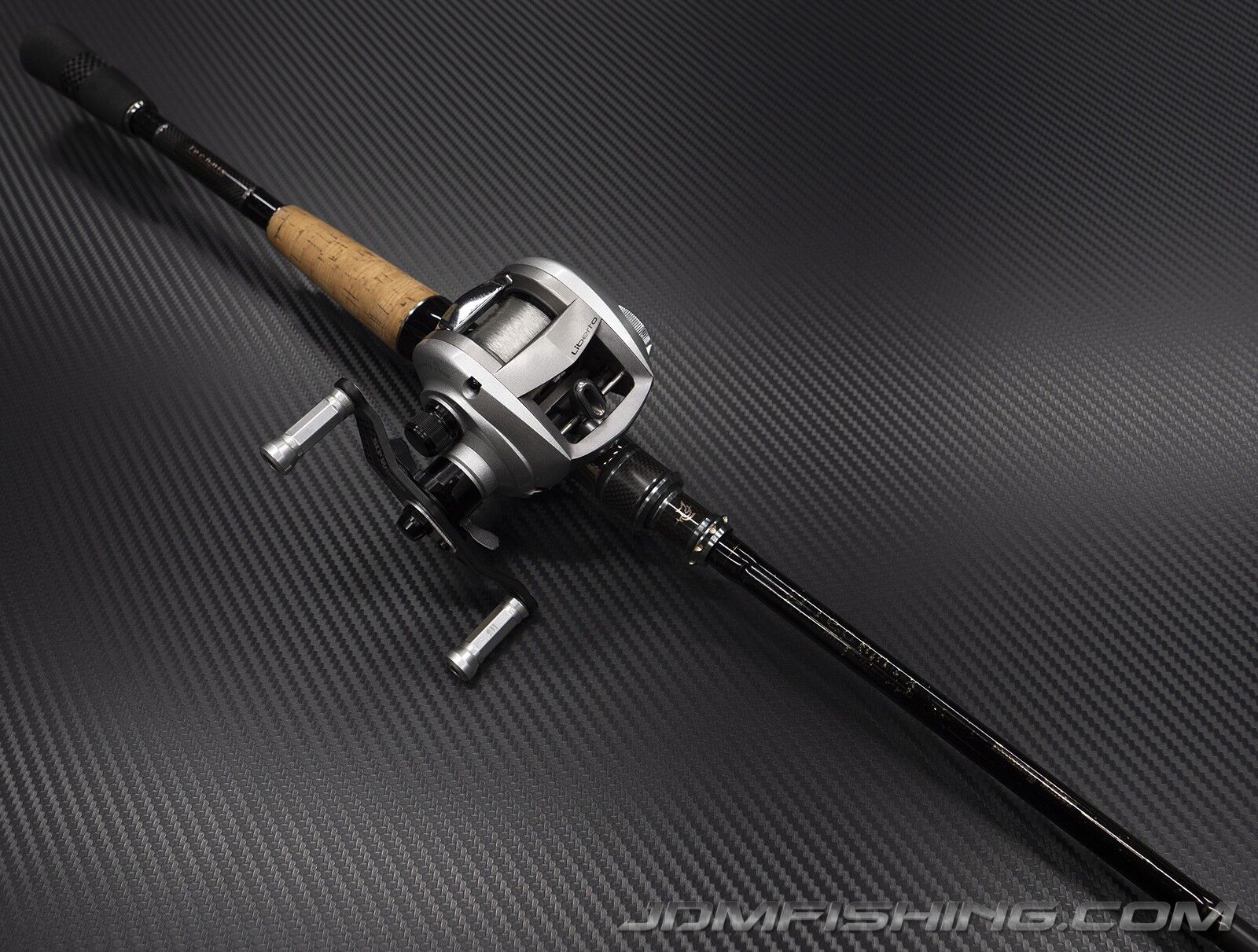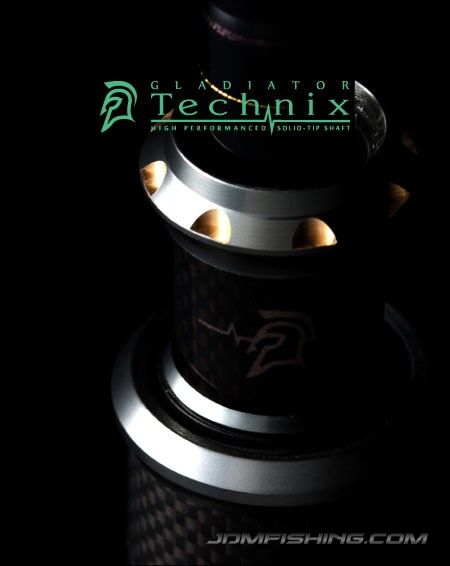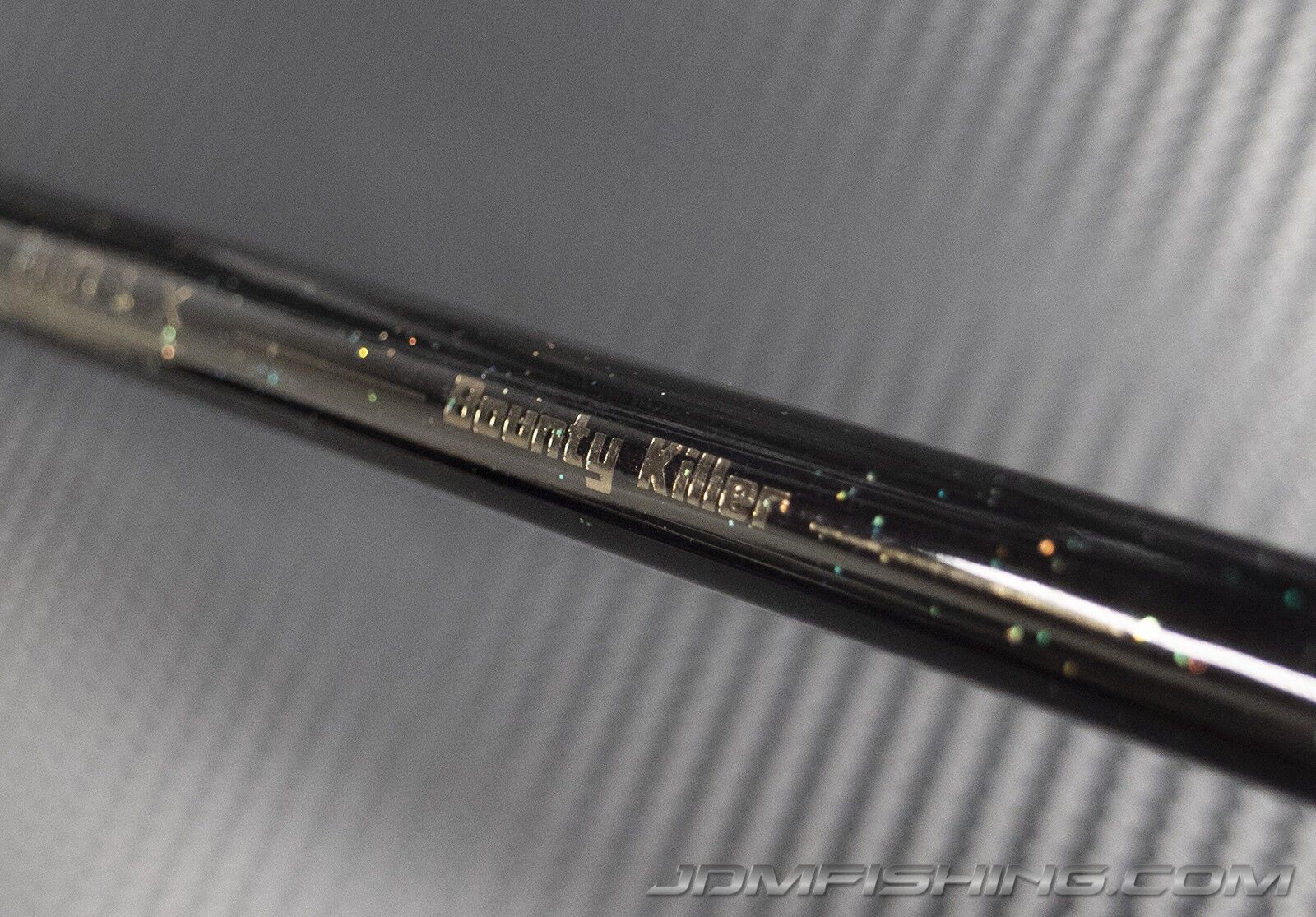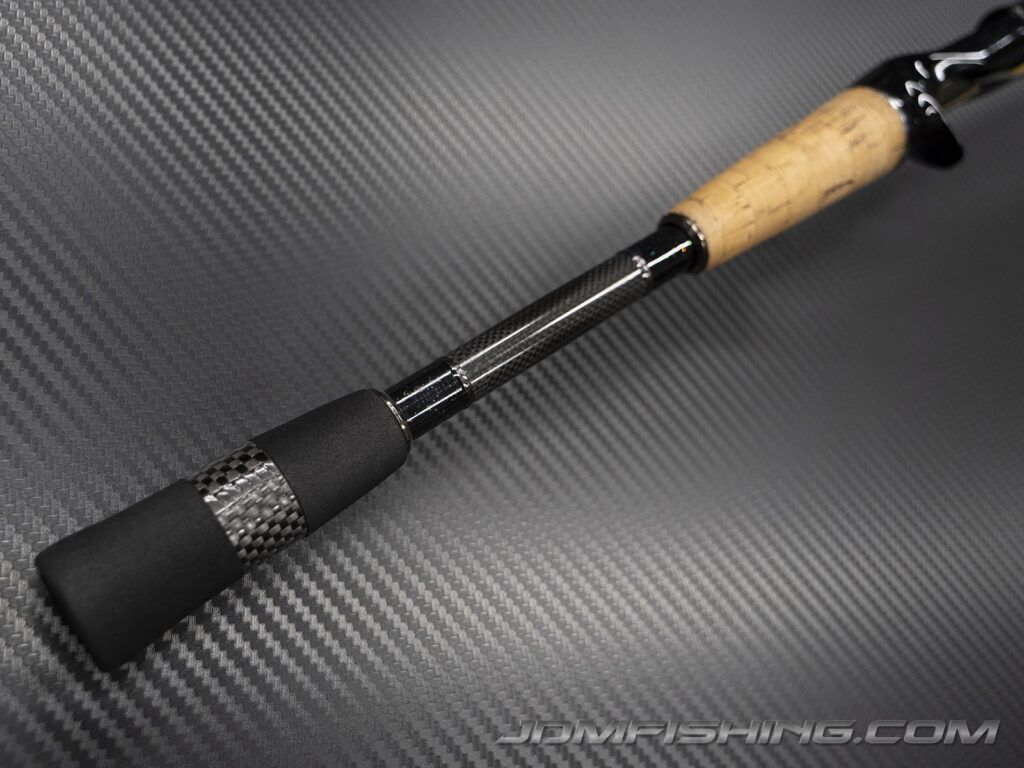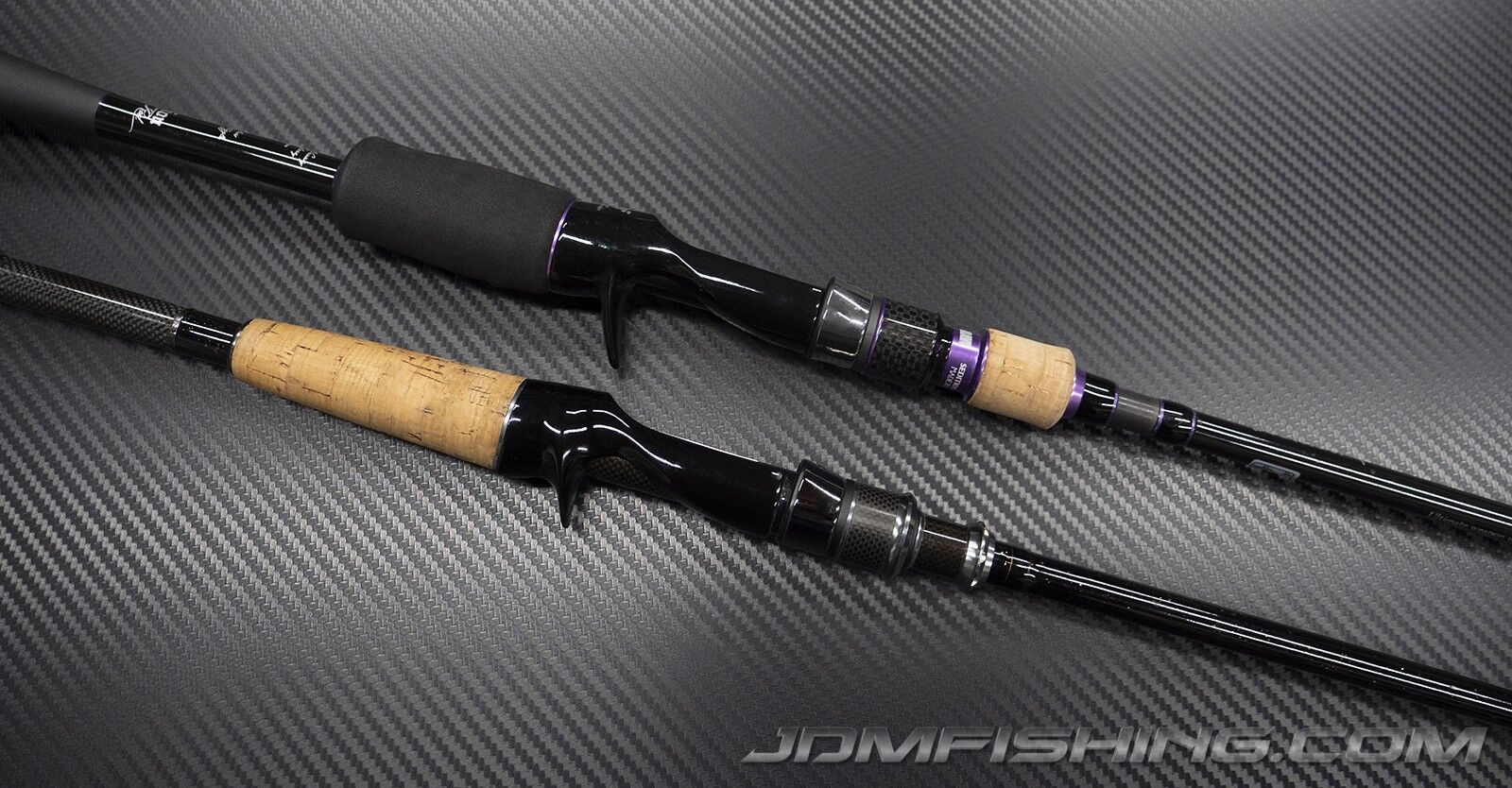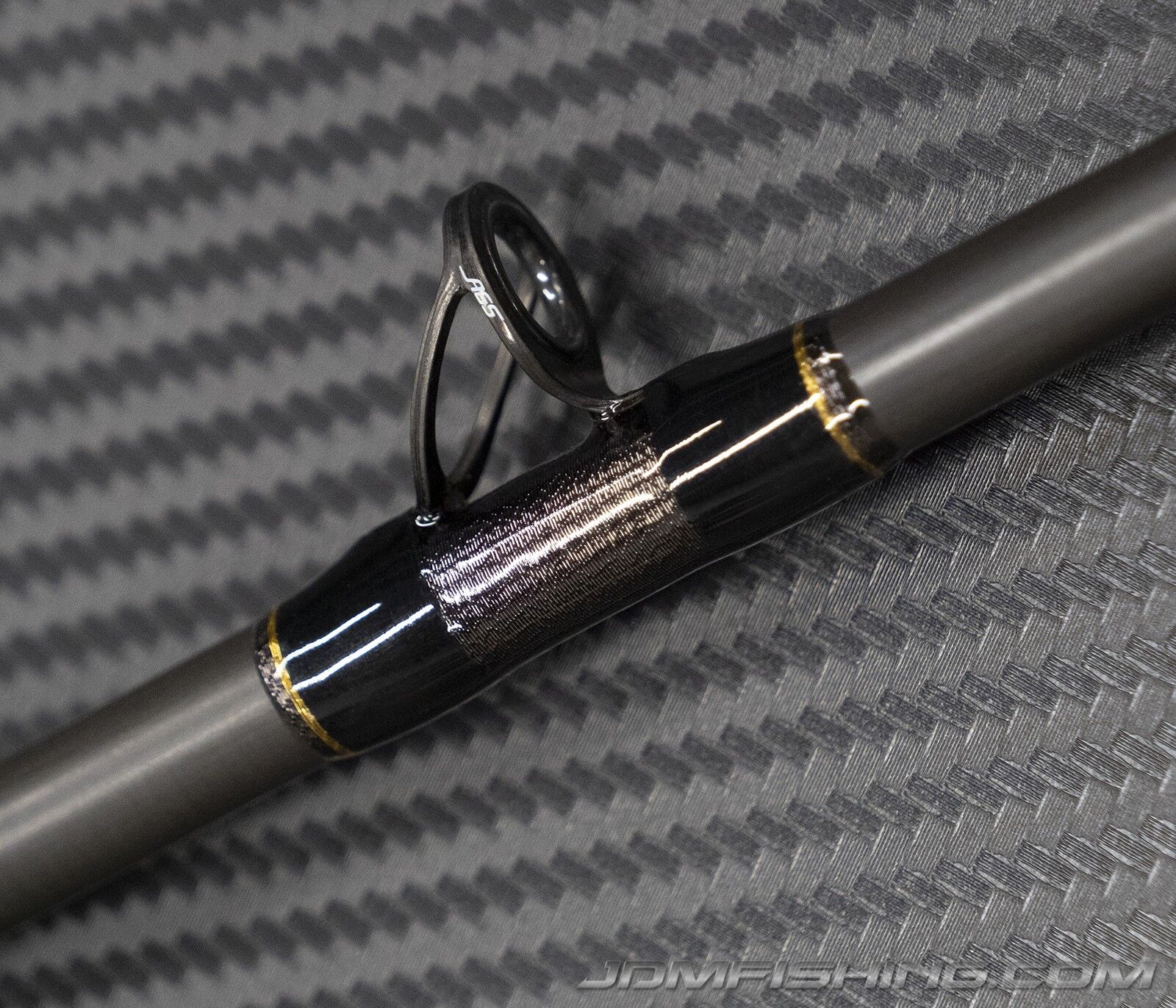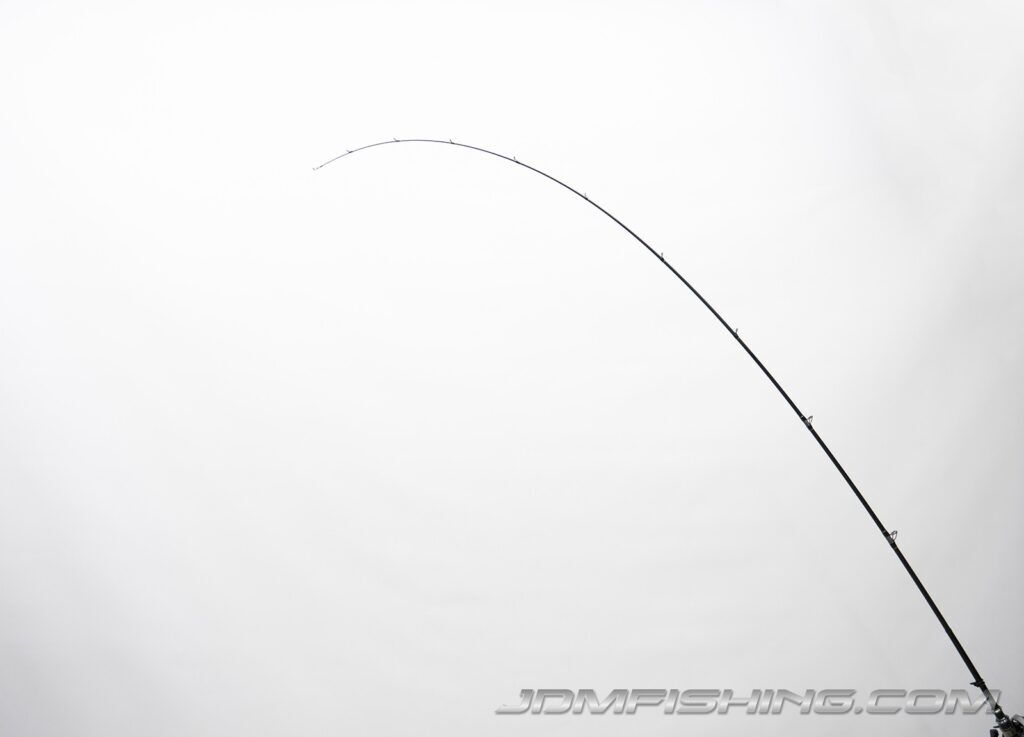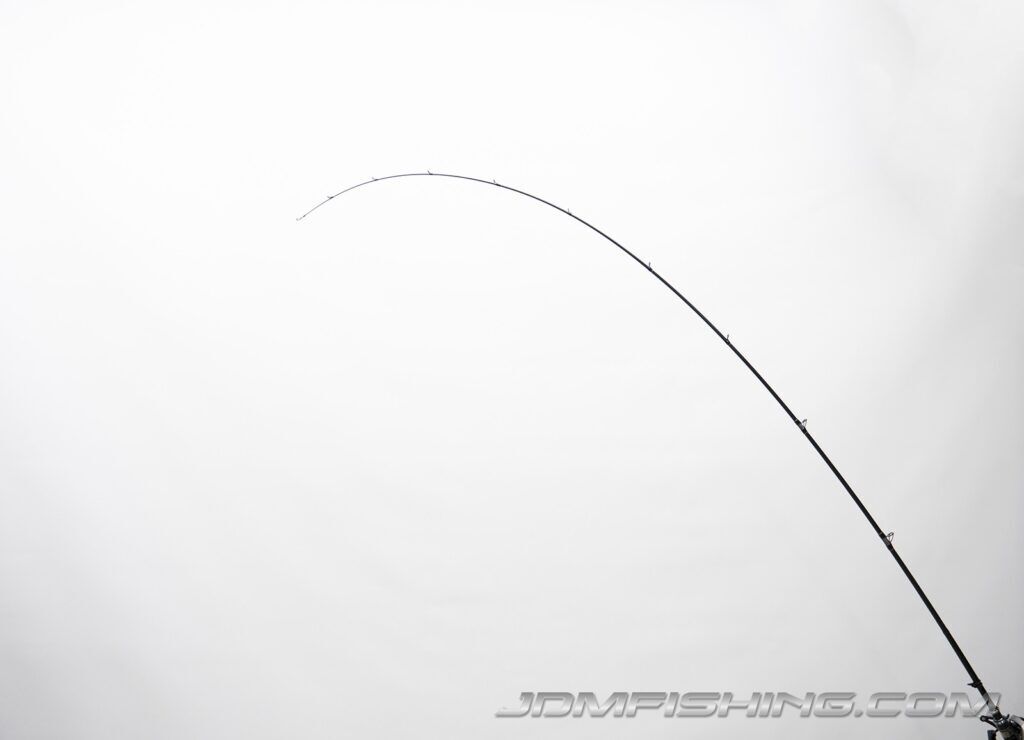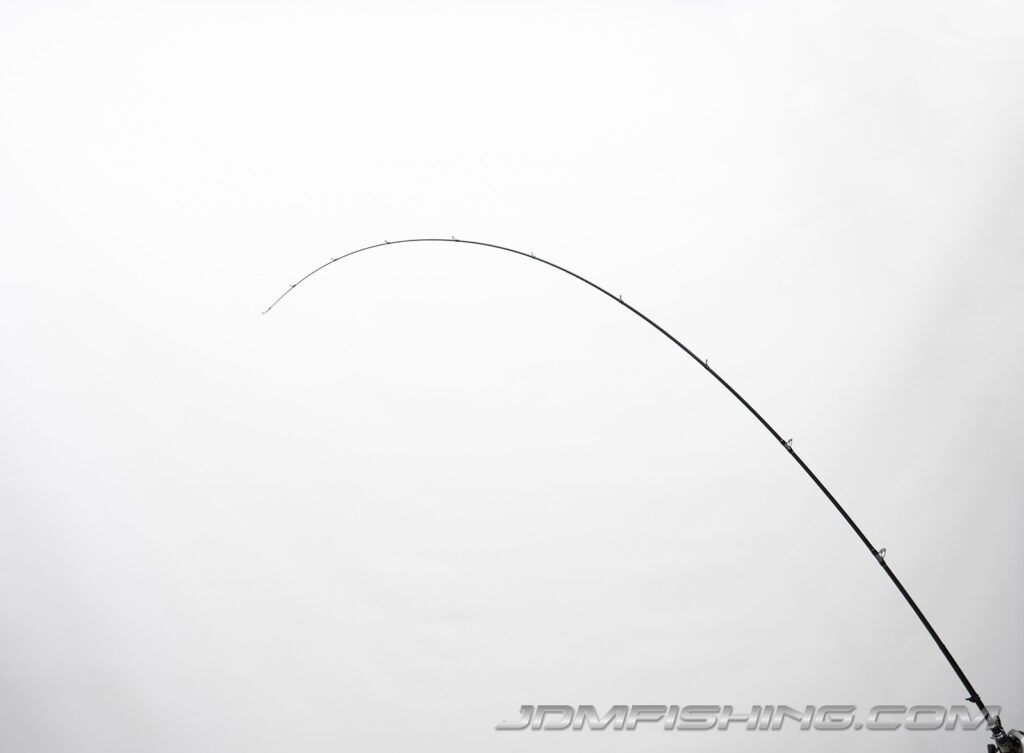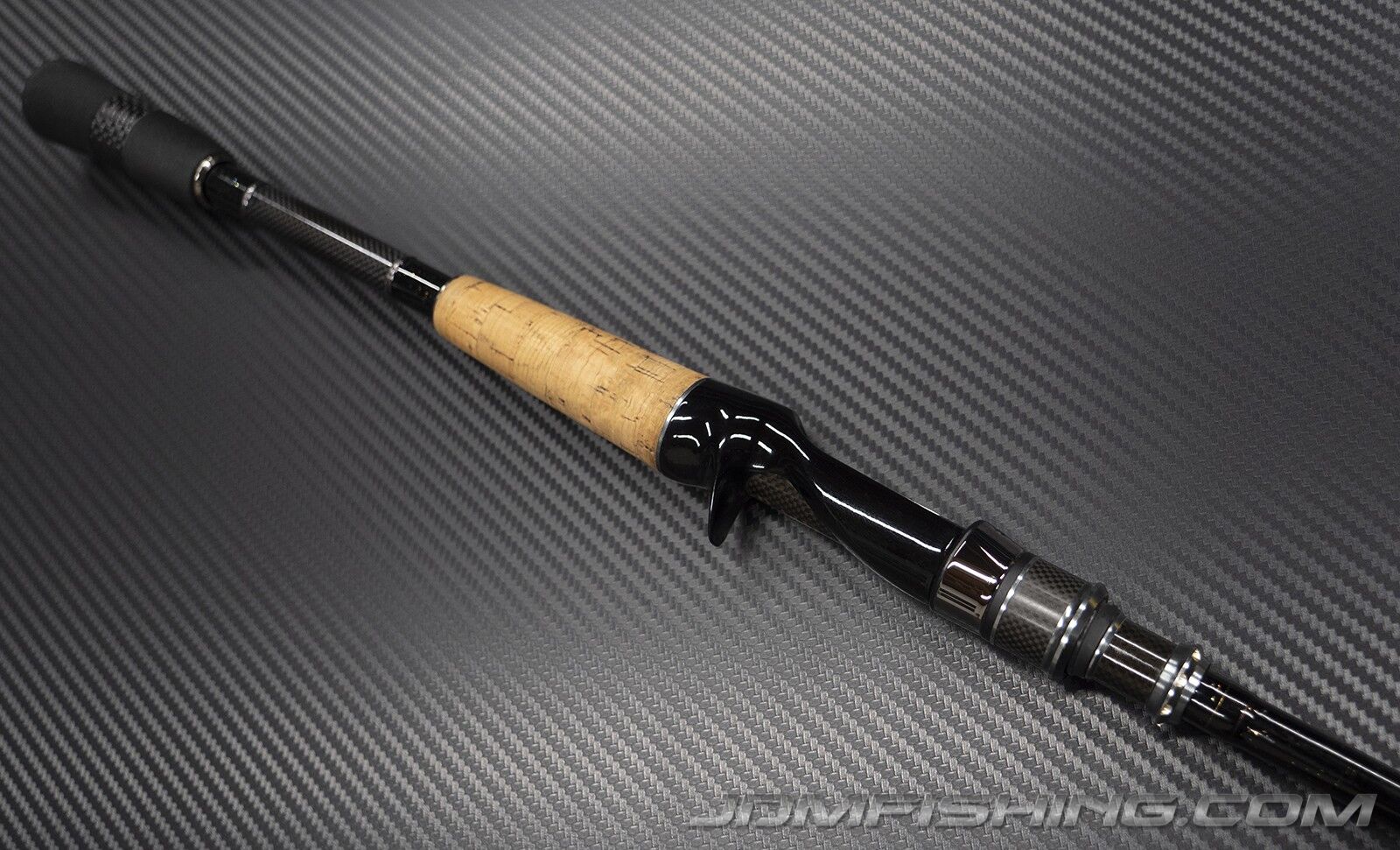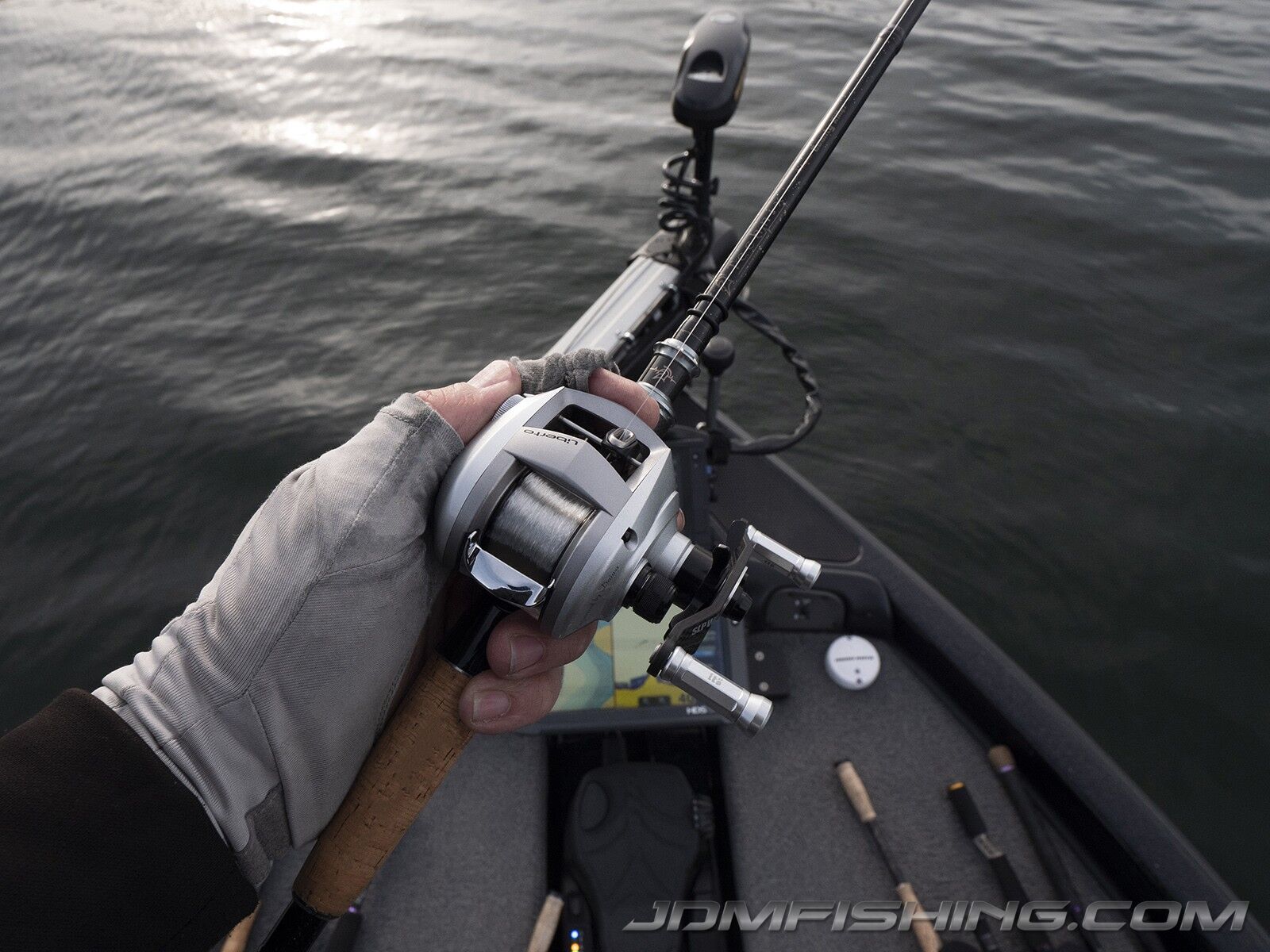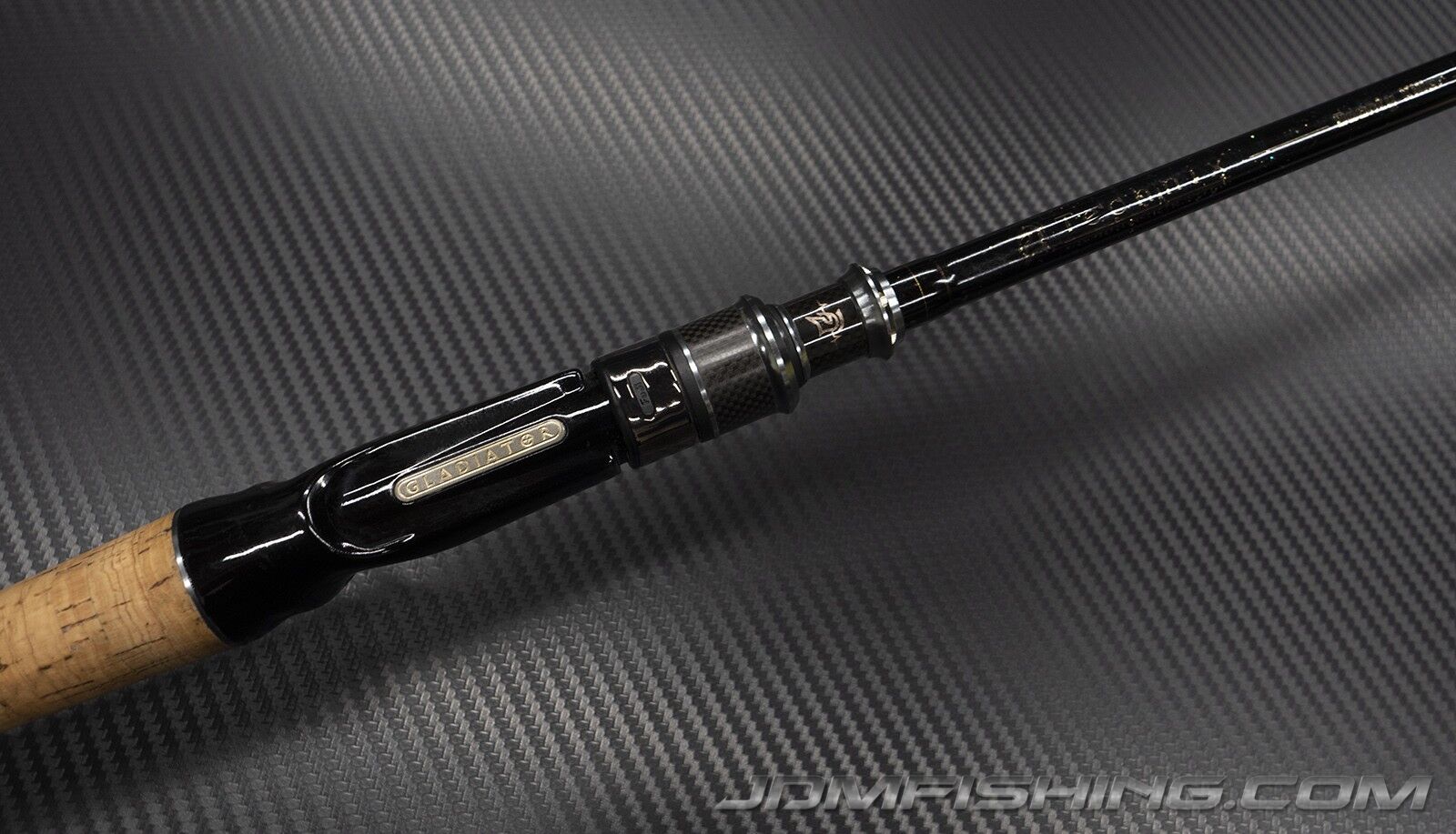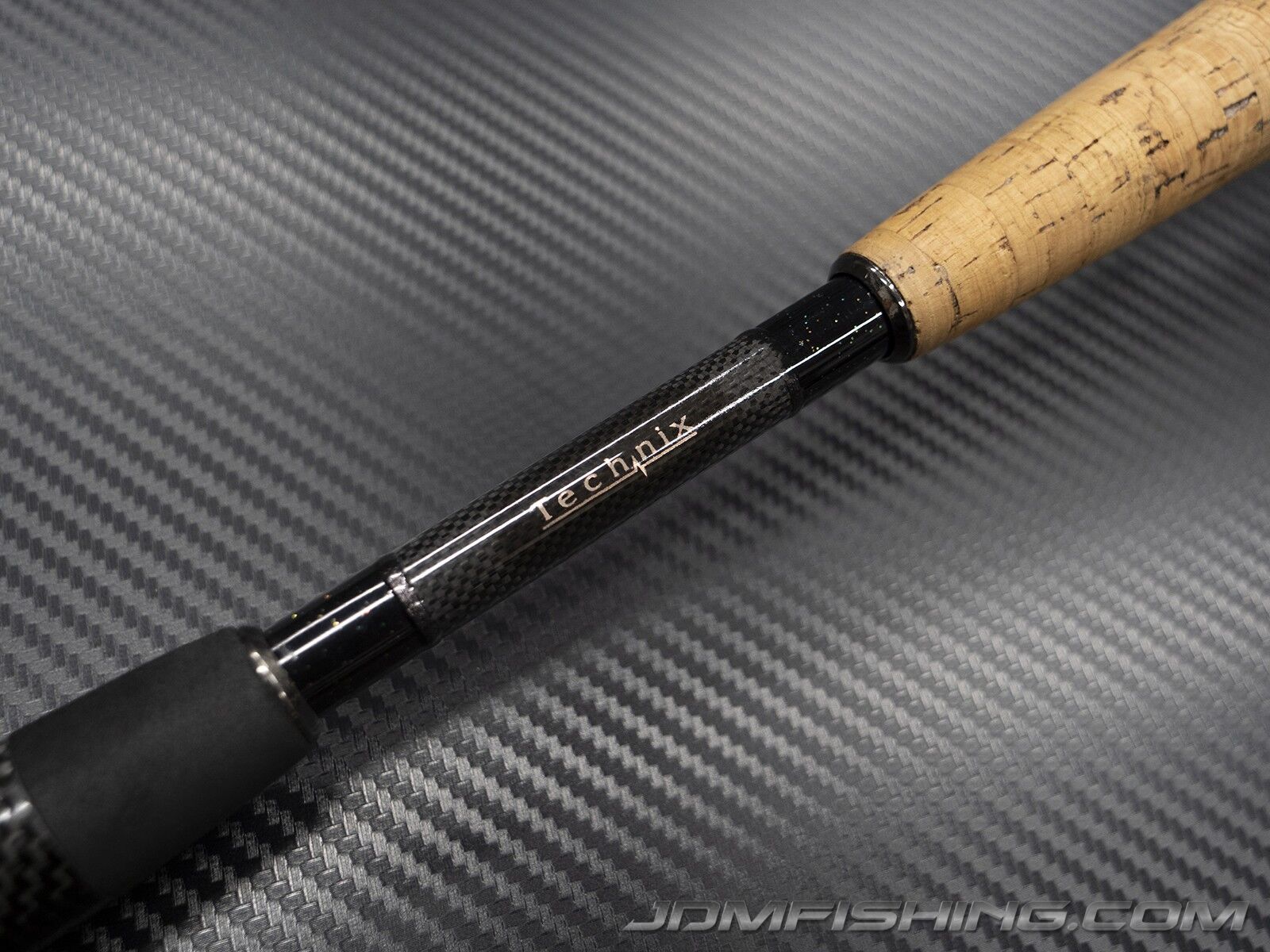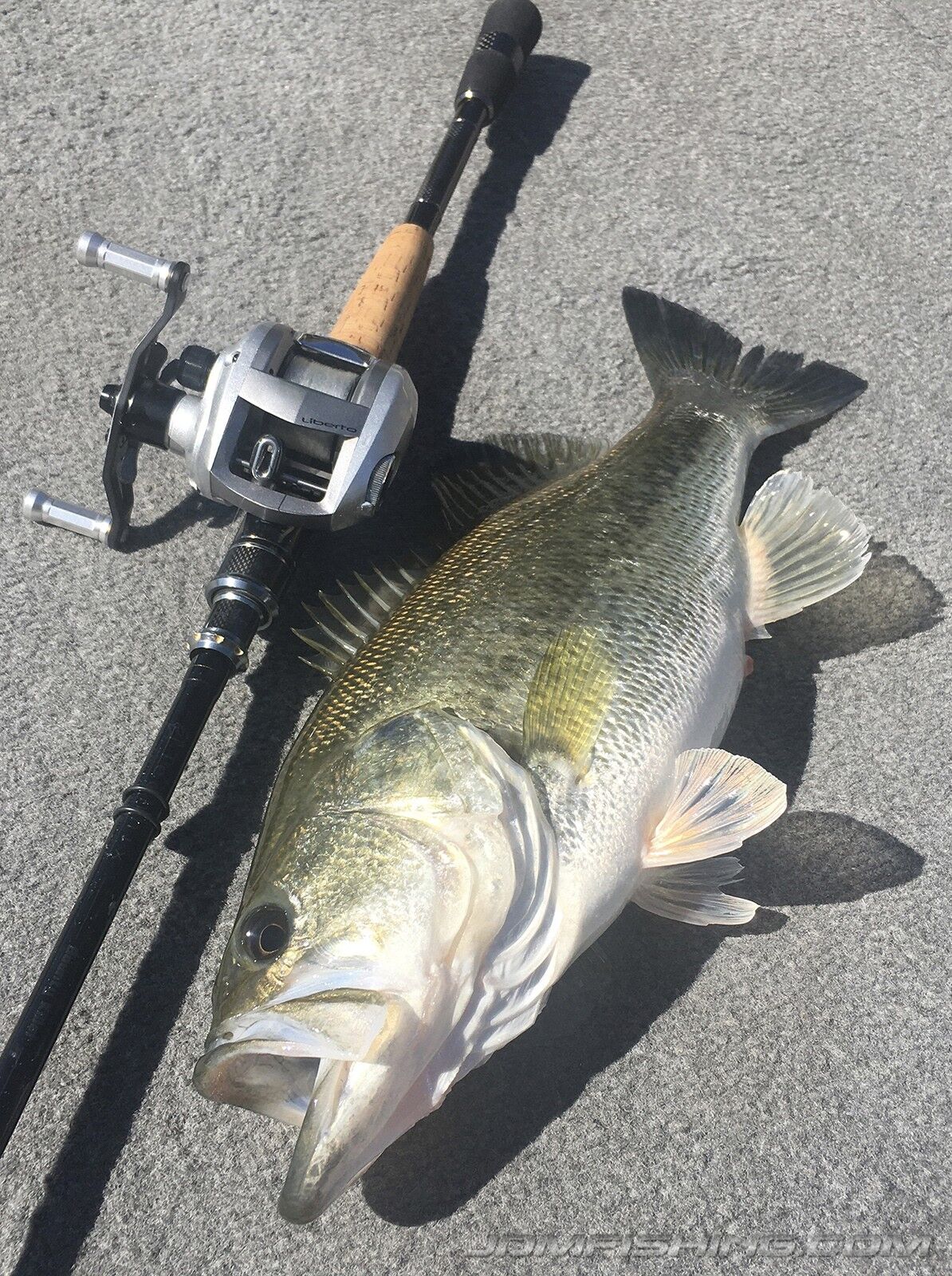The Breakdown
Manufacturer: RAID Japan
MSRP: N/A
Stock Form: 55000 JPY
As Tested: 68,500 JPY
Origin: Japan
Blank: High Modulus Carbon/Solid Tip
Length: 6’7”
Power: Medium Light Plus
Pieces: 1
Taper: X-Fast/Dual/Solid Tip
Lure: 1/16 – 1/2
Line: 6 – 14lb.
Stock Weight: 106.89 grams (3.77 oz.)
Prototype Weight: 95.74 grams (3.37 oz.)
Handle Lengths: Rear Grip 9.5”
Front of Trigger to Butt: 10 1/2”
Hood to Butt: 13”
Fore Nut to Butt: 14 7/8”
Grip Material: Cork/EVA
Reel Seat: Modified Fuji ECS
Guides: AGS (Daiwa Air Guide System) + SiC
Number of Guides: 10 (9 AGS + 1 SiC Tip)
Manufacturer Suggested Techniques: Multi purpose Bait Finesse focused on bottom contact.
JDMfishing.com Recommendations: Neko, Wacky Rig, Finesse Jigs, Ned Rigs, Drop Shot
Sensitivity: 4.25/5
Balance: 4.5/5
Power: 3.5/5
Special Notes: This is a one-off, custom prototype that never saw production.
Before I get into this writeup, I’d like to come out and admit that I’m not what most BFS “aficionados” would consider a true/hardcore BFS angler. To those out there slinging tiny 2-4g baits on UL-rated rods, 2lb. test, catching fish that should easily put a whooping on the gear your using, I salute you! I promise we will be delving much deeper into this widely popular and continuously growing culture as this section of our site grows, featuring write-ups from hardcore BFS enthusiasts. Now…to me, BFS describes any finesse-oriented technique utilized on lighter than normal line and lighter powered rods/tackle while using a bait casting reel. To many, light line/light tackle means 2-6lb line and only UL-L (Ultra Light to Light) rated rods, while to others (like myself), it includes rods into the ML (medium light) range and line up to 8lb test. “Power BFS” tops out at 10lb test in my humble opinion, but it’s all relative when it comes to what fish we are targeting and where we are targeting them. Not to mention, how our choice of tackle directly affects the lures we are using, but that’s a whole other topic.
I own a few Light powered sticks, but they don’t see a ton of use unless I’m targeting a smaller class of fish. For the type of fishing I do (Tournament and Recreational), and where I fish, anything less than a Medium Light-powered rod is almost suicidal. I’ve also fished and own many ML-rated offerings that are far more capable than their specs suggest, and can handle everything I need them to while usually being powerful enough to handle larger fish without feeling like I’m under-gunned. This writeup is about one of those special rods I’ve encountered along the way.
Some years back, while diving deeper into obscure rod manufacturers and their offerings, I accidentally stumbled across a very unique rod. A rod originally made by RAID Japan. The rod was a modified version of their Technix “Bounty Killer” model, a solid tip build, which was part of their Gladiator Series. Now RAID is not quite what I’d call an obscure brand by any means, but this rod, in and of itself, definitely is.
The rod was being offered up by a seller in Japan that I had bought from before and I was very much intrigued by what I was seeing. What made this rod so special? Well for starters, I noticed that the handle section was different from the standard version of the Bounty Killer in that it had a reshaped rear grip made from EVA with carbon fiber trim added along with a new butt cap.
esthetics
The Fuji ECS reel seat had been modified as the trigger was reshaped/made smaller and had been painted with a beautiful, gloss piano black finish. The winding checks were different from the stock iteration, utilizing Fuji parts and some details in the aesthetics had also been changed. What really got my attention was the guide train. The stock Fuji SiC guides had been replaced with a set of Daiwa’s AGS (Air Guide System) guides, and the wraps…are stunning. The information provided by the seller was that the handle section and guide placement were reworked for optimum balance and that this was a one-off prototype build for RAID done by a local builder in Japan. Even though I couldn’t confirm this with RAID themselves…I had to have it. At 68,500 JPY on the second-hand market, it wasn’t cheap but I’ll just say this…it was a bargain.
The top rod shows a Fuji ECS reel seat in stock form while the Bounty Killer AGS below shows the heavily modified ECS trigger.
TECH SPECS
The rod arrived a few weeks later, in mint condition and right off the bat, I was incredibly happy with how it felt in hand. It is very light weighing in at 95.74 grams (3.37ounces), The carbon-framed guides are perfectly aligned and the wraps are gorgeous. I did however notice that surprisingly, this incarnation of the Bounty Killer was slightly tip-heavy and immediately attributed this to the smaller EVA butt/rear grip. I’d be lying if I said this didn’t raise a little red flag, but that would change later. I compared it more closely to stock images and noticed the other subtle differences and details of this absolutely stunning rod that were not obvious in any of the pictures I had received from the seller. I investigated even further, cross-referencing images and specs to find that this modded prototype version was indeed a bit lighter than its stock iteration by 11+ grams and that the finished work included changes to the aesthetics that set this build far above the clean, yet understated original model. The revised details implemented are top shelf, and it made me wish that RAID had gone this route with their Gladiator Technix series as this rod’s sleek beauty speaks for itself. The smaller rear EVA grip is accented with an un-sanded carbon trim ring halfway through, and the butt cap is very cleanly integrated into the shaped EVA giving it a sharp, refined look. The cork main grip is a bit more tapered/shorter than the stock version, and the big difference within the handle section is the modded/painted Fuji ECS seat. The trigger has been reshaped while keeping its width, but the thickness and length of the protrusion have been greatly reduced. This makes for a reel seat that becomes even more comfortable and disappears with greater ease within the hand of the user. It just feels more natural and effortless to my hands, but of course, this is a matter of personal preference from user to user. Regardless, it’s a VERY nice modification in my book. The seat was then painted with a gloss black finish that’s beautifully done and has honestly stood up noticeably well to frequent use over the years.
A close-up shot of the AGS guide and beautiful thread work. This guide train was re-worked and placement was optimized along the blank to shift the balance point so that when a reel is mounted to the rod, it disappears in your hand.
TAPER TESTER
The taper tester reveals a nice x-fast tip section that quickly turns into that common dual taper that exists with most solid tip designs. Again, this is done to alleviate stress across the transition from the solid tip section into the tubular section of the blank, and it’s very effective in doing so. The downside?…sometimes, this can sacrifice a bit in the sensitivity department depending on the manufacturer/manufacturing process and materials used within the blank/tip sections. The upside?…this Bounty Killer is definitely NOT lacking in the sensitivity department. More on this later.
I decided it would initially be paired up with a heavily modded Daiwa silver mica Pixy/Pixzilla featuring a 7.2:1 gear swap, Carbontex Drag, PX68 finesse spool and a slew of other upgrades. I retrieved my favorite Pixy from the case and mounted it to the rod. Remember that mental note I had made about the rod being slightly tip-heavy?…yeah well, that was erased as soon as the Pixy was mated with the Bounty Killer. The rod disappeared, and I then knew that the handle mods, guide train and placement of components were done for this reason. It’s to this day, one of the most enjoyable, comfortable, and well-balanced combos I own. It truly stands out within my vast arsenal and at the time, I couldn’t wait to get this combo out on the water.
Everything on this rod was re-worked from the ground up including a handle section that was lightened on the back-end. This was done for a specific reason.
ON THE WATER / SENSITIVITY & POWER
I had a two-day club championship coming up at Lake Havasu and the Bounty Killer AGS would get to take its first victims at this event. I had never fished the rod prior to this, but I was confident it was going to be a capable stick. Tied onto the end of the 8lb Sniper FC, first, was a Neko-rigged Zoom Swamp Crawler dangling from a 1/0 Owner weedless wacky rig hook and stuffed with a 1/32oz Eco Pro tungsten nail weight. The Bounty Killer in combination with the PX68 finesse spool easily loaded and launched the light rig as far as I needed it to, and then some. After the first few casts I was enjoying the overall feel of the rod and as expected, that nice solid-tip section was proving itself great for imparting action. I could very clearly feel what was going on at the end of my line. Believe me…not all solid tips are created equal. A few casts later, the cold morning yielded the first fish of the day. A nice, light tap on the fall immediately following a quick twitch of the rod tip was clearly defined and just what I was hoping for. I quickly reeled in the slackline and swung. A brief battle with the smaller 2.25+lb. fish yielded good control and the Owner hook had that fish pinned. I had to take note that the sensitivity of this stick really is just plain outstanding and the more time I spent with it, the more it was showing me what it was…and wasn’t capable of. I could easily feel the worm dragging against and coming across the soft to hard bottom transitions. A change to, or contact with vegetation instantly registered up the line and to my fingertips. Even more importantly, when something picked up my rig, no matter how light the bite was, I really never questioned it. I own other rods that are exceptional in their abilities to do this, and the Bounty Killer was standing shoulder to shoulder with them, even surpassing a couple of favorites that I could think of off the top of my head. You know that feeling you get when a rod just does everything right? I for one, become immersed in every cast when that happens, and that was the case with the Bounty Killer.
Two more fish in the 3lb. the range were added to the live well on the Neko, but the bite had since gone quiet. I threw a couple of other baits (on other setups) to no avail, and after about an hour, I decided to change it up and tie on a Ned rig. I went with a 1/10 oz. Z-man Shroomz Head with a weed guard and a Zoom TRD. Once again…the Bounty Killer was adept at launching the small rig and I got more than enough distance, easily and accurately hitting my marks at will. I very slowly crept along the shoreline consisting of rock, mud, and some sparse brush. Working the Ned with short pops, and then letting it sit for varying amounts of time ranging from 1-6 seconds proved effective. Again, I was impressed with how clearly the “tap” or “light thud” of the jig head hitting rock or softer bottom was transmitted to my fingers. The Bounty Killer is a winner in this department, and the AGS guide train was only adding to this clear picture it was painting while keeping everything effortless and extremely well-balanced.
Talk about a combo that actually disappears in hand, this one is really hard to beat.
I was about a dozen casts in when the Ned rig was hit hard, surprisingly while I was in the middle of a long pause. I set the hook, and the fish took off, pulling drag briefly before heading upwards. I quickly stabbed my rod tip into the water, hoping to keep the fish from jumping, but she broke the surface and shook her head…It was a good one. The fish dove again making another run in the opposite direction and this was where the tables turned. With 8lb test spooled on, I had defaulted to a being bit too cautious with my drag setting and quickly tried to adjust as I needed to keep this fish away from the brush to the right of me…which of course, she was heading straight towards. I did my best to get dialed in and steer her away, but unfortunately, it was too late…the ML-rated rod was losing the battle. This fish had shoulders and barreled towards deeper water, pulling more drag and bringing my line around the backside of the brush in front of me. At that point, I could clearly feel the line rubbing and being shredded as it was pulled against the base of the brush. Shortly thereafter, the Sniper FC failed. My teammate, unaware that the fish had broken off, still stood ready with the net, but she was gone. That uncomfortable silence set in, and honestly, I was a bit disappointed in myself. I replayed the tape in my head several times, thinking about what I should’ve/could’ve/would’ve done differently and all the things we run through in our head when we lose a good fish. I also had to come to terms with the fact that although this rod had impressed me in so many other ways, it just didn’t have the power I needed to turn that fish and capitalize. Sometimes we win, and sometimes we lose…that’s fishing. This definitely stung a bit, but it also made me take note. I needed to adapt, be more aware and make sure I wasn’t putting myself in these situations again.
Another shot of the gloss-black reel seat and slightly different aesthetics from the stock version.
We continued on, as I rotated between three rigs while fishing the Bounty Killer AGS. A Neko rig, a Ned rig, and a Keitech Tungsten Mono Spin Jig at 1/16oz with a 4” Robo worm FX trailer that also proved deadly later in the day. While all three techniques were well within the wheelhouse of this one-off rod, the Neko did the most damage and yielded the best casting results being it was the heaviest of the three. But don’t let that fool you, this rod is capable down to the 1/16 oz. rating it is given in the stock form. Of course, the reel plays a big part in this, but the rod’s ability to load up properly down to its bottom end rating is just as, if not more important. I am able to make slightly better than decent casts with that 1/16 Keitech Mono Spin Jig although I’d prefer a total weight of 1/8 oz and above to get into optimum casting performance. As mentioned previously, the light, capable tip section of this rod is outstanding for imparting action on your lure, as it can easily add slight trembling with just a light shake, or erratic twitches will make things dance. This tip section will also very much help capitalize when it comes to those half-hearted light bites, allowing a fish to inhale your offering much more easily than other tubular rods that can often pull a lure away prematurely, costing you fish. It’s a VERY well implemented solid tip.
The cork main grip and rear EVA grip were shortened, therefore, lengthening the split grip section. New winding checks and wraps were added at each end of the section.
Later in the day, I was presented with another opportunity, but conditions and circumstances were different. I was fishing a deeper hard bottom cove with some small rocky secondaries within it. I launched the Neko just past a large boulder a couple of meters out from the shore and before the worm had a chance to hit bottom through the clear waters, I saw a shadow dart out from the rock. I felt that wonderful “tap” and watched as my line shifted directions, suddenly moving horizontally. A quick snap of my wrist got the hook into her and with open water around the boat, I was able to play the 4+lb. fish making for an fun, leap-filled fight. While the Bounty Killer did a great job, I again found myself wishing I had just a tiny bit more power on tap, but within that statement, I emphasize the fact that I was fishing a tournament, and wanted these fish in the boat as fast as possible. The important thing is that the rod allowed me to capitalize on most of my bites, detecting some that I feel I would’ve never noticed with other rods I own. Not to mention, the Bounty Killer put all but one of those fish in the boat.
Switching up to the Keitech Mono Spin Jig got me the bites I needed when it got really tough, and the tiny jig/trailer combo was actually a lot of fun to fish. I could easily feel the bottom as I slowly dragged the ball-head Mono Jig, and the 8lb test Sniper aided in reducing a slower fall rate that triggered a couple of finicky fish to engulf it on the initial drop. I landed several more before the end of the tournament as this rod stayed in my hand most of the time, allowing us to cull and upgrade our total weight.
While this first outing made for a great test, I have to admit, I probably shouldn’t have been using this rod for the first time during a tournament, as I was definitely a bit more “high-strung” and not in a prime “open-minded” position to be testing out a stick I’m not familiar with. Not smart on my part, but in the end, this tournament actually yielded better than normal testing conditions, and really became the basis for this article, as the rod rose to the occasion, only losing one battle, that was honestly more user error than anything else.
Fast forward a few years, and this Unicorn remains one of my absolute favorites. I reach for it as often, if not more often than most of my other ML rated sticks. I’ve never had an issue with any of the components and the AGS guides that so many fear remain in perfect condition/alignment. It has landed countless fish, with my biggest taken on it being just shy of 5lbs, while spooled with 7lb sniper, which yes…was an intense battle to say the least. The Bounty Killer has earned a permanent spot within my BFS lineup, which is limited to only about a dozen or so rods that fit within that category. I’ve fished several different reels on it, but I always seem to come back to that original pairing with the Silver Mica Pixzilla 7.2/PX68 Finesse custom spool. When you go through as many different variables/combos/mods as I do, it’s always a great feeling to find that pairing that feels like it was meant to be. When you do, you just leave it alone.
I use it primarily throw…you guessed it, a Neko rig. Usually, it’s tossed on 7lb. Sniper FC if I’m fishing for fun, but it also handles 10lb. test incredibly well during tourneys. The 10 lb test allows me to apply that extra pressure when needed, giving me the ability and confidence to turn larger fish in a hurry. Yes, again I know the 10lb test is not what BFS guys consider true “BFS”. This moves into that Power BFS realm, but for the settings, conditions, and possible size of fish being caught, that’s light enough for comfort in my book, especially when money is on the line. Note, I am mentioning the use of 10 lb test as more of a reference for what I like to throw on the top end of the spectrum for the Bounty Killer. There’s no doubt in my mind that 5-6 lb. test would be incredibly well-handled by this rod and as mentioned, I feel it’s rated specs are very accurately assigned. I’ve also thrown small jerkbaits, spy baits, and darter heads with great success on this rod.
THE VERDICT
The Bounty Killer AGS is yet another prime example of something I firmly believe… putting any given rod through lots of different tests and finding out it excels at far more than originally anticipated. Just like so many other JDM offerings, this ML+ rated rod has the ability to do many things, but I personally prefer to exploit its sensitivity, taper, and casting abilities while fishing finesse plastics. It’s got the power to get past a light weed guard, or Tex-posed plastic offering quite well, but I lean towards open hook applications with it.
The strength of this rod lies within that outstanding balance, lightness, sensitivity, and overall sexiness. Many higher-end rods these days are sensitive enough for the duties described, but when you get to this level, a rod-like this has a way of creating an almost heightened sense of awareness. When I’m in contact with what’s happening at the end of my line, I’m much more focused, and that’s what this rod brings out in me. This rod keeps my attention centered around what my lure is doing, while also allowing me to be more accurate when it comes to the action I’m imparting. In my opinion, the aforementioned translates into putting more fish in the boat.
The weaknesses?….that tiny amount of extra power I wish it had within the butt of the blank, being that the rod is dubbed a “ML+”. To me, an ML+ rated stick should have a bit more on tap into that lower section of the blank, but that falls under personal preference rather than being some kind of flaw. Just be mindful of your surroundings and go to a heavier line if you are fishing around obstacles that could end up being a factor while battling fish.
That said, this rod’s strengths far outweigh any weaknesses.
The other problem is that this version of the bounty killer was never produced for the consumer, which is truly a shame. This rod, in my opinion, could’ve been “the one” that became an instant legend within the Technix lineup.
Another problem…the Gladiator/Technix series has been discontinued, but the original Bounty Killer can still be had on the second-hand market. I highly suggest grabbing one if you’re able to. This modded version of the rod obviously has advantages over the stock version, but having fished other RAID offerings within the Gladiator series, I can safely assume that even in stock form, this rod will not disappoint. RAID is one of those companies that is often overlooked when it comes to true enthusiast-level rods, and they shouldn’t be.

